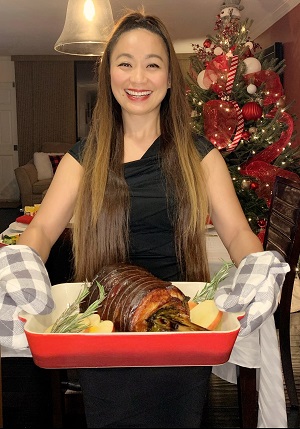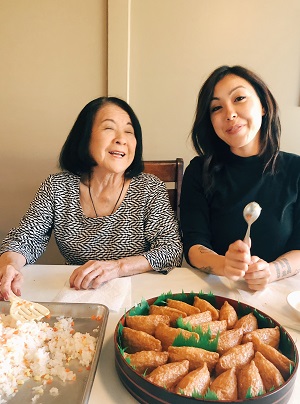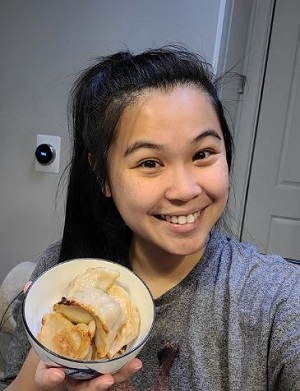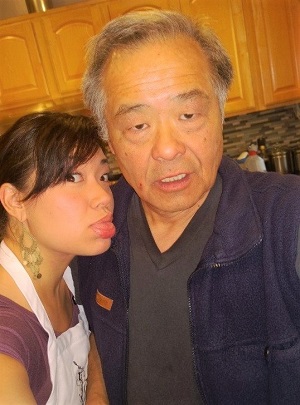Food is a form of communication. It tells us stories, expresses identity, and preserves and transmits culture and tradition — all in one bite. The whole process of preparing and enjoying traditional family meals becomes particularly important when you’re part of a diaspora, distant from homeland or heritage. The recipes we hold onto and pass down are sometimes the strongest cultural connections we have, and that’s why food can mean far more than just sustenance.
In honor of Asian American and Pacific Islander Heritage Month, five of our CHG Healthcare team members reflect on how traditional food has helped them maintain roots in their cultures. And they’ve also shared family recipes to try in your own home!
Filipino lechon

When it comes to Filipino food, no one can say no to lechon! In my culture, lechon, which is a whole slow-roasted pig, means celebration and tradition. Every family has their own way of cooking it, but it’s usually prepared with aromatics such as lemongrass, garlic, and onions and turned over a fire for 16 hours. The whole neighborhood knows a big feast is ahead.
Lechon is a reminder of those special occasions around a shared table. No Christmas is complete without it in the Philippines. In America, I’m not able to roast an entire pig, so I’ve adapted my recipe to use pork belly instead. It’s important to me to keep that tradition alive for my daughter who is a teenager now. We feel so much pride in our heritage, and I never want her to lose sight of where she came from.
To hold onto our culture, we speak the language in our home, remain active in our church, and eat all of the delicious Filipino food I grew up on. — Grace Wilson, a recruiter at RNnetwork
Try Grace's lechon recipe here.
Japanese inarizushi

I’ve always had a bit of a complicated relationship with my heritage. As a half-white, fourth-generation Japanese American who grew up in a predominately white suburb in Utah, I’ve often felt like I’m living between different identities and cultures. I am also the granddaughter of a Japanese American internment camp survivor — my grandpa Frank. And, while this event was rarely talked about in our home, it certainly had a lasting impact on my family’s cultural identity. The language, many of the traditions, and even my grandpa’s first name (Kametaka) faded away after years of assimilation. But we found a strong sense of community and belonging in other ways, particularly in the homestyle Japanese food we cook and eat.
I learned how to make inarizushi, which is an oval-shaped type of sushi wrapped in a seasoned tofu wrapper, sitting at my grandma’s kitchen table. She told me, “whatever you do, you can’t mess up the rice,” as she gently cooled a sheet pan of rice with a paper fan. She taught me how to wet my hands with sushi vinegar and delicately fill the wrappers. We then tasted an inari together, admiring the flavors and aromas that are distinctly Japanese. It’s a dish packed in school lunches, eaten on road trips, and arranged on a family-style platter for New Year’s Day dinner. It’s a dish I grew up on and a flavor that makes me feel most at home. — Reiko Turner, a communications specialist at CHG Healthcare
Check out Reiko's inarizushi recipe here.
Chinese dumplings

My grandma has always fed me dumplings. Early on in my life, I made it known that I loved dumplings — pan fried, to be specific. When I moved out to Salt Lake City, I could not find the usual brand of dumplings that I’ve eaten since childhood, and it devastated me. I searched high and low, eating through bags of frozen dumplings from different brands, but I just couldn’t find that specific taste that I was longing for. I called my family, desperate, contemplating if I should ask them to ship me the frozen dumplings that I craved.
Luckily, my aunt has been collecting all our family-favorite Chinese recipes from my grandmother, and those dumplings happened to be one of them! My aunt and my grandmother used to wrap dumplings together when she was a little girl, obsessed with dumplings herself. My first foray into dumpling making was challenging to say the least. The wrappers took forever to roll out, I spent hours prepping the ingredients and wrapping the filling up, and my little dumplings ended up looking like a disaster. But I was never discouraged. It’s less about how the dumplings look on the outside and more about the delicious filling inside.
In my first bite, I found the taste and flavor I was missing. I was overcome with memories of my grandmother walking out of the kitchen with a plate of dumplings just for me, memories of sitting at the table with my siblings, scrambling over the last one. It was the taste of home. — Heather Thai, a credentialing specialist with CHG Healthcare
Follow Heather's dumpling recipe here.
Japanese sukiyaki

Sukiyaki is one of those dishes that has a million variations and changes by region. Every family (and restaurant) has a different version. My grandmother used to cook for the family once a week, and sukiyaki was always one of our favorite dishes. Now that my grandmother has passed, my dad and I cook sukiyaki for our whole family and a few friends. In the fall, we prepare a special version of sukiyaki with a rare mushroom, the Matsutake. As the dish cooks, the whole house smells like a pine forest. It’s umami, salty, and savory. At the end of cooking, you crack a few eggs into the pot and serve it boiling hot with a bowl of rice. It’s great with or without the mushrooms, but if you can get your hands on some, they’re amazing!
Unfortunately, there is so much we learned from being in the kitchen with my grandmother that isn’t written down. But my dad and I are committed to creating a book of recipes, so our family doesn’t lose the wonderful dishes my grandmother perfected. This Japanese cook does a great job giving the background on sukiyaki and has an easy-to-follow recipe. To try it my family’s style, add bamboo shoots, mung bean sprouts, substitute with Matsutake mushroom, and use saifun noodle (cellophane noodle) instead of udon. — Adrienne Nakamura, a project management director at CompHealth
Try Adrienne's sukiyaki recipe here.
Interested in working for a company that celebrates diversity? Take a look at our current openings.